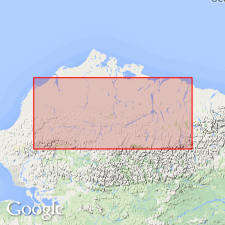
- Usage in publication:
-
- Chandler formation*
- Modifications:
-
- Named
- Dominant lithology:
-
- Sandstone
- Conglomerate
- Shale
- Coal
- AAPG geologic province:
-
- Alaska Northern region
Summary:
Named as nonmarine formation in Nanushuk group. Type locality designated on Chandler River where river crosses Northern Foothills section, northern AK. Contains two major tongues (named), Hatbox and Niakogon tongues and several minor tongues (unnamed) which intertongue with Umiat formation (new) of Nanushuk group. In southern exposures consists mostly of sandstone and conglomerate. To north grades into shale with interbedded sandstone and coal. Is about 4700 ft thick. Overlies Tuktu member (new) of Umiat formation. Unconformably underlies Prince Creek formation (new) of Colville group. Is age equivalent of Umiat formation, Early Cretaceous and Early(?) Cretaceous.
Source: GNU records (USGS DDS-6; Menlo GNULEX).
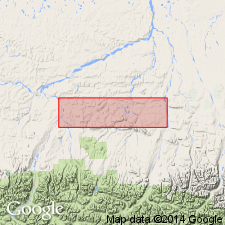
- Usage in publication:
-
- Chandler formation*
- Modifications:
-
- Revised
- Age modified
- AAPG geologic province:
-
- Alaska Northern region
Summary:
Lithologic unit remains much the same as originally defined by Gryc and others (1951), but lower tongue (Hatbox tongue) is renamed Killik tongue (new) and type locality for both tongues have been changed. Northward and eastward, Chandler formation intertongues and grades into its marine equivalents of Nanushuk group, Grandstand and Ninuluk formations (both new). Age is Early and Late Cretaceous based on age assigned to Niakogon tongue which overlies Ninuluk formation that contains abundant specimens of INOCERAMUS ATHABASKENSIS McLearn of late Cenomanian age.
Source: GNU records (USGS DDS-6; Menlo GNULEX).
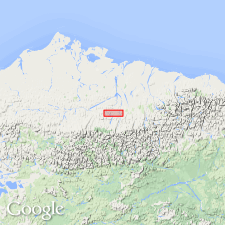
- Usage in publication:
-
- Chandler formation*
- Modifications:
-
- Areal extent
- AAPG geologic province:
-
- Alaska Northern region
Summary:
Marine Grandstand and nonmarine Chandler formations undifferentiated are geographically extended in subsurface into test wells in Grandstand area, northern AK.
Source: GNU records (USGS DDS-6; Menlo GNULEX).
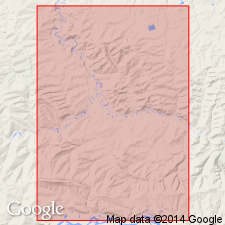
- Usage in publication:
-
- Chandler formation*
- Modifications:
-
- Areal extent
- AAPG geologic province:
-
- Alaska Northern region
Summary:
Killik tongue of Chandler formation present in Titaluk test well No.1 and in Knifeblade test wells. Also present in Titaluk test wells are a few nonmarine beds associated with Ninuluk formation which are fingers of Niakogon tongue of Chandler formation.
Source: GNU records (USGS DDS-6; Menlo GNULEX).
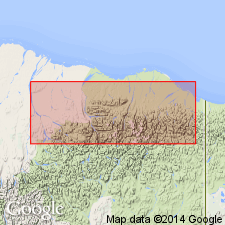
- Usage in publication:
-
- Chandler Formation*
- Modifications:
-
- Reference
- Age modified
- AAPG geologic province:
-
- Alaska Northern region
Summary:
Reference section designated on Sabbath Creek, tributary of Jago River, northeastern AK. Thickness is 4775 ft. Lithologic description given in stratigraphic column. Age is considered middle and late Albian because Chandler Formation overlies early middle Albian PARAGASTROPLITES beds of Tuktu Formation. All Cretaceous beds in northern AK of Cenomanian or younger age contain abundant bentonite or tuff. Consequently Chandler in northeastern AK cannot be younger than late Albian [Early Cretaceous].
Source: GNU records (USGS DDS-6; Menlo GNULEX).
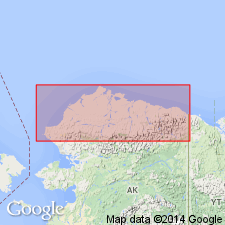
- Usage in publication:
-
- Chandler Formation†
- Modifications:
-
- Abandoned
- AAPG geologic province:
-
- Alaska Northern region
Summary:
Pg. 5 (fig. 4), 6-8 (table 1), 12. †Chandler Formation of Nanushuk Group. Abandoned. Rocks reassigned to unnamed upper part (nonmarine) of Nanushuk Formation (revised). The †Killik and †Niakogon Tongues of the Chandler are also abandoned. [See Nanushuk.]
Source: Publication.
For more information, please contact Nancy Stamm, Geologic Names Committee Secretary.
Asterisk (*) indicates published by U.S. Geological Survey authors.
"No current usage" (†) implies that a name has been abandoned or has fallen into disuse. Former usage and, if known, replacement name given in parentheses ( ).
Slash (/) indicates name conflicts with nomenclatural guidelines (CSN, 1933; ACSN, 1961, 1970; NACSN, 1983, 2005, 2021). May be explained within brackets ([ ]).

